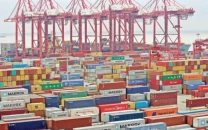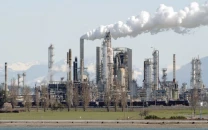Oil up near $68 as supply cuts outweigh economic worry
Expectations of a further drop in US inventories support prices

Expectations of a further drop in US inventories support prices. PHOTO: REUTERS
The price of global benchmark Brent crude has risen about 25% in 2019, supported by supply curbs by the Organisation of the Petroleum Exporting Countries (OPEC) plus allies, and involuntary losses due to US sanctions on Iran and Venezuela.
Brent was up 63 cents at $67.84 a barrel at 1126 GMT, not far from its 2019 high of $68.69 reached on March 21. US crude added 81 cents at $59.63.
Oil prices hit by worries of sharp economic slowdown
"It appears that concerns about demand have taken something of a back seat," Commerzbank analyst Carsten Fritsch said. "Instead, market participants are focusing on the tight supply situation again."
Expectations of a further drop in US inventories also supported prices, suggesting the OPEC-led curbs were helping to avert a buildup of excess supplies.
The first of this week's supply reports, from the American Petroleum Institute, is due at 2030 GMT. US crude inventories are forecast to have fallen by 2.4 million barrels in what would be a third straight weekly decline.
Further price support came from another power cut in Venezuela, the second to hit the OPEC member this month, raising concern about the country's oil exports.
Worries about demand have limited oil's rally as manufacturing data from Asia, Europe and the United States pointed to an economic slowdown, although bullish bets by some investors are rising.
Oil slips but holds near 2019 peak as supplies tighten
"So far, demand concerns have not proven too much of a headwind," analysts at JBC Energy wrote.
Investor concern over the global economy had intensified on Friday after disappointing German and US factory data led to an inversion of the US Treasury yield curve, which some see as a leading indicator of recession.
"Recession risks have risen to the highest since 2008," said Ole Hansen, head of commodity strategy at Saxo Bank.



















COMMENTS
Comments are moderated and generally will be posted if they are on-topic and not abusive.
For more information, please see our Comments FAQ